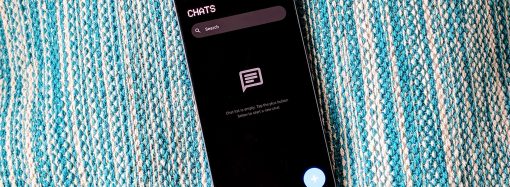Introduction In today’s busy world, heading to the gym isn’t always possible. Yet staying healthy and strong matters more than ever. With smart planning and the right moves, you can build muscle, burn fat, and boost energy—all with home workouts. No expensive equipment or monthly fees required. By focusing on bodyweight exercises, simple tools, and
Introduction
In today’s busy world, heading to the gym isn’t always possible. Yet staying healthy and strong matters more than ever. With smart planning and the right moves, you can build muscle, burn fat, and boost energy—all with home workouts. No expensive equipment or monthly fees required. By focusing on bodyweight exercises, simple tools, and clear goals, you create a sustainable fitness habit. This guide covers what makes a great home Exercise Routine, top exercises to try, ways to stay motivated, and tips to see real progress. Ready to transform your living room into a personal gym? Let’s get started on the path to staying fit without a gym.
What Is a Home Workout?
A home workout uses little to no equipment and relies on your body’s own weight for resistance. You can do these exercises in a small space—your living room, bedroom, or even a hallway. The goal is to target all major muscle groups and raise your heart rate for a complete fitness session. Unlike gym sessions tied to heavy machines, home workouts offer flexibility. You choose the time, pace, and intensity. This makes them ideal for busy parents, remote workers, and anyone who values convenience. As long as you have a flat surface and an open area, you’re ready to exercise and boost your health at home.
Why Choose Home Workouts?
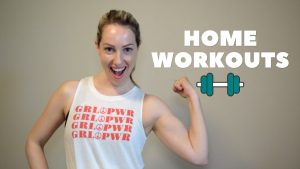
Image by: Yandex.com
Many people ask why they should try home workouts instead of a gym membership. First, saving money is a big plus; no monthly fees or expensive gear. Second, you gain time by cutting out the commute to a gym. Third, working out at home reduces stress—you can exercise in comfortable clothes and a private setting. Fourth, home sessions fit any schedule: early morning, lunch breaks, or right before bed. Finally, home workouts build self-discipline as you learn to push yourself without an instructor watching. With consistency, you can reach the same goals you would at a gym, all while enjoying freedom and ease.
Key Components of Effective Home Exercise
To get the most from home exercise routines, focus on three pillars: strength, cardio, and flexibility. Strength comes from bodyweight exercises like squats and push-ups. Cardio gets your heart pumping with moves like jumping jacks or high-knees. Flexibility and recovery rely on stretching and yoga poses.
Table: Core Components of Home Workouts
| Component | Exercise Examples | Main Benefit |
|---|---|---|
| Strength | Squats, push-ups, lunges | Builds muscle, tones body |
| Cardio | Jumping jacks, burpees | Burns calories, improves heart |
| Flexibility | Hamstring stretch, yoga | Prevents injury, improves mobility |
| Core | Plank, mountain climbers | Strengthens abs, supports spine |
Balancing these areas prevents muscle imbalance and keeps workouts fresh. Aim to include each component at least once a week for complete fitness.
Top Bodyweight Exercises to Try
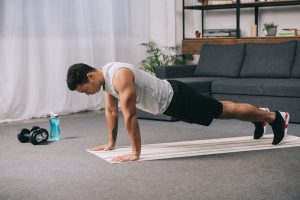
Image by: Yandex.com
For staying fit without a gym, these bodyweight exercises deliver big results:
Bodyweight Exercises
Bodyweight exercises are an excellent way to build strength, endurance, and flexibility. These exercises require no equipment and can be done in any space, making them perfect for a home workout routine. Here are a few examples:
Squats target your thighs and glutes. Stand feet hip-width apart, bend knees, and lower as if sitting. Keep your back straight and chest up. Rise and repeat.
Push-ups work your chest, shoulders, and arms. Place hands shoulder-width apart on the floor, legs extended, body in a straight line. Bend elbows to lower, then push up.
Lunges strengthen legs and improve balance. Step one foot forward, bend both knees to 90 degrees, then push back. Alternate sides.
Planks build core strength. Hold a push-up position on forearms and toes, keeping a straight line from head to heels.
- Burpees combine squat, plank, and jump for a full-body cardio blast. Squat, kick back to plank, return to squat, then jump up.
Why They Work: These exercises are great for beginners and advanced fitness levels alike, and they can be scaled in difficulty depending on your fitness goals.
Yoga and Pilates
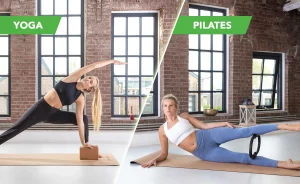
Image by: Yandex.com
Yoga and Pilates have become incredibly popular for home workouts due to their focus on flexibility, strength, and mental well-being. In 2025, people are using these methods to reduce stress and improve posture, balance, and flexibility.
What to Try:
- Vinyasa Yoga: A flowing style of yoga that emphasizes breath control and movement.
- Power Yoga: A more intense form of yoga that focuses on strength and stamina.
- Pilates Reformer (with Equipment): This is an excellent choice if you have a Pilates reformer machine, but even without equipment, mat-based Pilates can be highly effective.
Why They Work: Yoga and Pilates improve both mental and physical health, making them perfect for home workouts. These exercises also help with recovery and relaxation, which is important for overall well-being.
High-Intensity Interval Training (HIIT)

Image by: Yandex.com
HIIT workouts are short, intense bursts of exercise followed by short rest periods. This method is extremely effective for fat burning and improving cardiovascular health, and it can easily be done at home with minimal or no equipment.
Resistance Training
Resistance training builds muscle and helps increase metabolism. While free weights are ideal for resistance training, you can also use resistance bands or even household items like water bottles.
What to Try:
- Bicep curls with dumbbells or water bottles.
- Tricep dips using a sturdy chair or bench.
- Leg raises to tone the lower body.
Why They Work: Resistance training is crucial for increasing muscle mass, which in turn helps with fat loss and improved metabolism. It’s an excellent addition to any home workout routine.
What to Try:
- Jumping Jacks: Full-body exercise that gets the heart rate up.
- Mountain Climbers: Great for the core and cardio.
- High Knees: Effective for warming up and getting your blood pumping.
- Speed Squats: Increase the intensity of basic squats by adding speed.
Why They Work: HIIT workouts are perfect for busy individuals who need to fit in a fast, intense workout. They are also great for improving both strength and endurance in a short period of time.
Building a Simple Home Exercise Routine
Creating a home exercise routine that works means setting structure. Follow these steps:
- Warm Up: Spend five minutes on light cardio—marching in place or gentle jumping jacks—to raise your heart rate.
- Main Workout: Choose four to six bodyweight exercises. Do each for 30–45 seconds, rest 15 seconds, then move to the next. Complete three or four circuits.
- Cool Down: Finish with five minutes of stretching, focusing on muscles you worked most.
For example: warm up with high-knees, then do squats, push-ups, lunges, planks, and mountain climbers in a circuit. Cool down with hamstring stretches and shoulder rolls.
Schedule workouts three to five times a week. Track your progress with a simple journal or app. Gradually increase duration or speed to keep improving.
How to Create Your Home Workout Routine
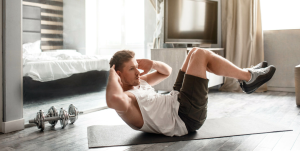
Image by: Yandex.com
1. Set Clear Goals
Before starting your home workout journey, decide what you want to achieve. Whether it’s building strength, losing weight, or improving flexibility, having clear goals will help keep you motivated.
2. Choose a Balanced Routine
Make sure your workout routine includes a variety of exercises that target different muscle groups. A balanced routine should include strength training, cardio, flexibility exercises, and recovery time.
3. Schedule Your Workouts
Consistency is key to seeing progress. Set a schedule that works for you, whether it’s 3, 4, or 5 days a week. Treat your workouts as appointments that you can’t skip.
4. Track Your Progress
Use a fitness app or journal to track your workouts and progress. This can help you stay motivated and see how far you’ve come.
Tips for Staying Motivated at Home
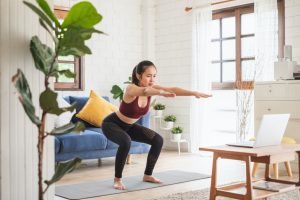
Image by: Yandex.com
Keeping up with home workouts can be challenging without the gym’s energy. Here are strategies to stay on track:
Set clear, small goals: aim to do a 20-minute session five days a week.
Use music or podcasts to keep workouts fun and engaging.
Build a workout space—even a corner with a mat—so exercise feels special.
Join online communities or challenge friends to share progress.
Reward yourself with a healthy meal or new workout gear after hitting milestones.
Be flexible: if you miss a session, do a shorter quick workout rather than skipping entirely.
Consistency beats perfection. Small steps every day add up to big changes over time.
Conclusion
With the right plan and mindset, home workouts let you maintain health, strength, and energy without a gym. By focusing on bodyweight exercises, balanced routines, and motivation strategies, you can build a fitness habit that lasts. Remember the key components: strength, cardio, and flexibility. Follow our sample routine, track your progress, and celebrate each win. Your living room, backyard, or hotel room can be your personal gym, wherever life takes you. Embrace staying fit without a gym and unlock a healthier, more confident you—right from home.
Call-to-Action: Ready to transform your fitness routine? Choose three Bodyweight Exercises from this guide and start your first home workout today. Share your journey with #HomeWorkout2025 and inspire others!






